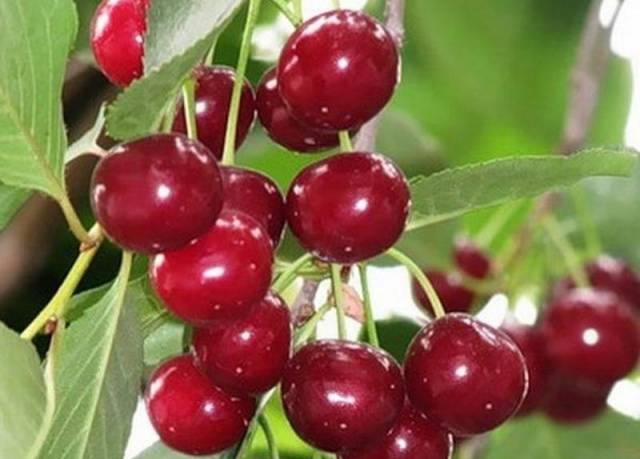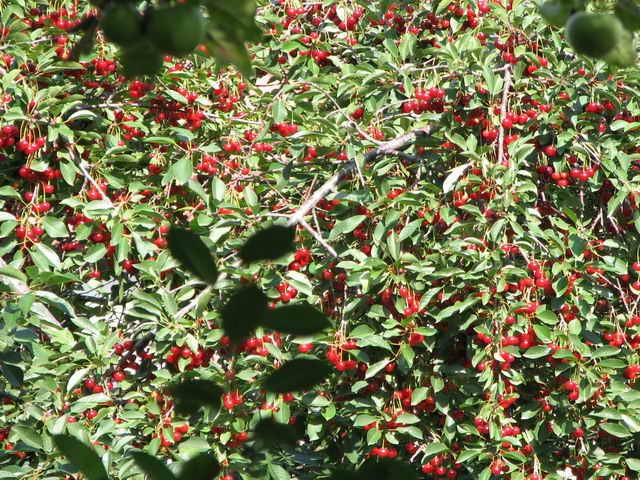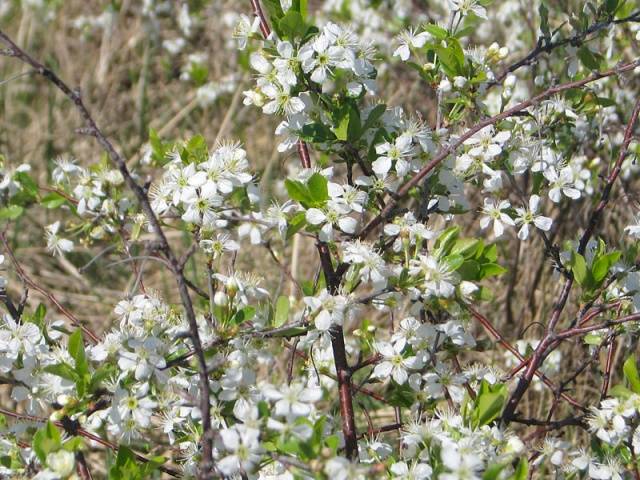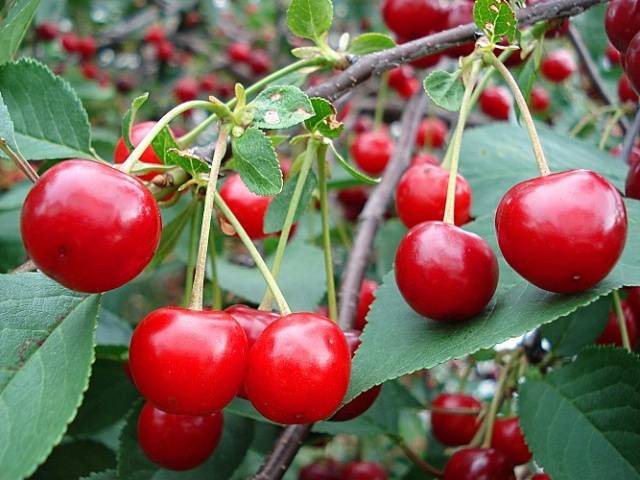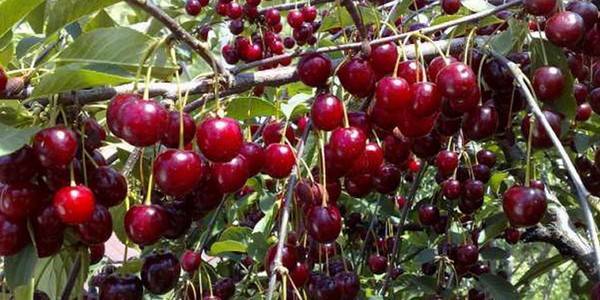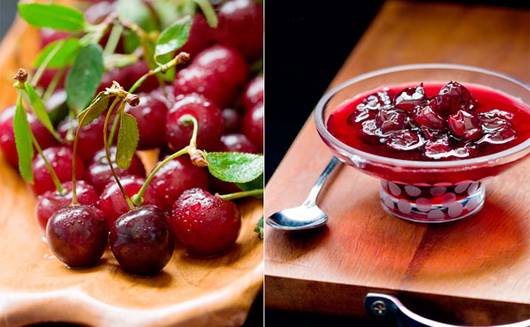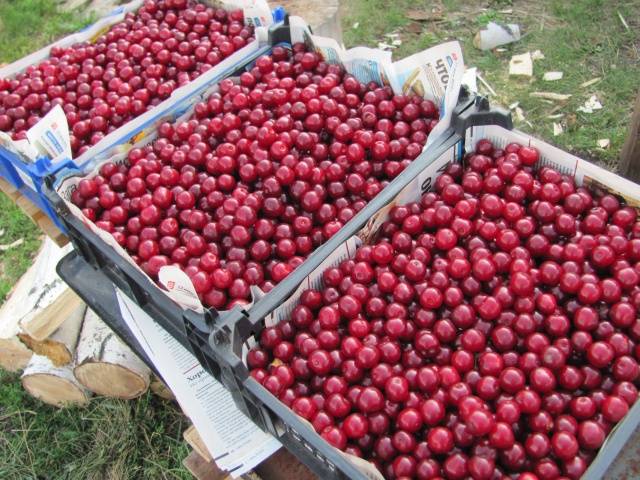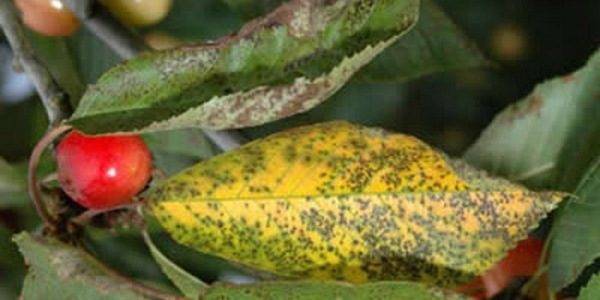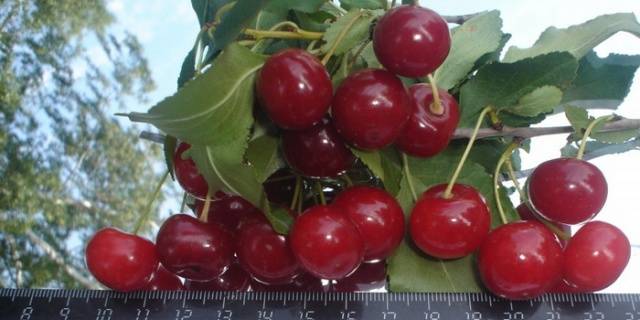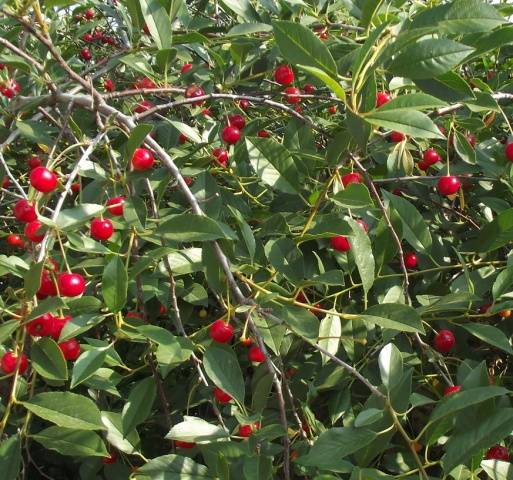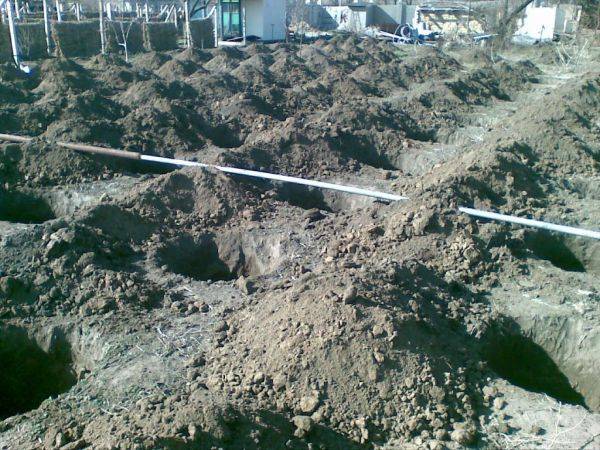Content
Of 150 types of cherries, only 5 are edible - steppe, felt, Magaleb, common, not found in nature today, and sweet cherry. All varieties are bred by selective selection or cross-pollination of wild relatives. How many cultivars exist today is not known for certain, new ones constantly appear, and the old ones “go out of circulation” as hopeless or are destroyed by coccomycosis. Cherry Uralskaya Rubinovaya is an old variety that will remain in demand in the north of Russia for many decades to come.
Breeding history
The Uralskaya Rubinovaya variety was created by the Sverdlovsk Horticultural Selection Station in 1954. In 1955, the cherry was transferred to the State Classification Testing, and 4 years later (1959) it was accepted by the State Register. Developers of the variety - S.V. Zhukov and N.I. Gvozdyukova.
Uralskaya Rubinovaya is a hybrid of steppe cherry, obtained from crossing the Ideal variety with other Michurin cultivars. It was bred specifically for the cold climate of Siberia and the Urals. Today, the variety is used to create new varieties, acting as a donor of yield, short stature, frost and drought resistance.
Description of culture
The Uralskaya Rubinovaya variety, like other steppe cherries, grows not as a tree, but as a shrub. It reaches a height of 1.5 m. The shape of the crown is broadly round, with spreading, drooping branches. Young shoots are colored green, then become purple-brown and bare. Leaves obovate, with a sharp tip and jagged edges. The upper part is dark green, the lower part is light. Flowers are formed on annual shoots or bouquet twigs.
The fruits of the Ural Ruby cherry are medium-sized, dark red, rounded, weighing up to 3.5 g each. The variety belongs to the morel (griots). This means that the pulp and juice are colored red. The taste of the fruit is satisfactory, sweet and sour. The stone is small, it separates well from the pulp. The stalk of medium length is firmly attached to the cherry and does not allow it to crumble after full ripening.
The Uralskaya Rubinovaya variety is approved for cultivation in all regions. Cherry feels best in regions with a more than cool climate - Volgo-Vyatka, Ural, West Siberian.
Characteristics
Less than 30 varieties of steppe cherry are included in the State Register of the Russian Federation, one of them is Uralskaya Rubinovaya. Despite almost seven decades that have passed since the registration, the seedlings of this cultivar continue to be in demand.
Drought resistance, winter hardiness
Cherry variety Uralskaya Rubinovaya was bred specifically for cultivation in areas with severe winters. It is believed to be able to adapt to any weather conditions, including prolonged droughts. The buds and wood are able to withstand frosts below 35 degrees. To a large extent, the variety owes its resistance to freezing due to its small size - this shrub cherry in winter is 2/3 covered with snow.
Pollination, flowering and ripening period
Ural Rubinovaya belongs to the late varieties - depending on weather conditions and the region, it blooms in late May - early June. Fruiting begins in the second half of August. Thanks to the strong attachment of the berry to the stalk, you can wait not for technical, but for full ripeness, without fear that the cherry will crumble.
Late flowering periods allow not only to get away from spring frosts in the northern regions, but also to wait for the release of beneficial insects. This is especially important because the plant is self-fertile. The best pollinators for cherries of the Uralskaya Rubinovaya variety are Polevka, Alatyrskaya, Mayak, Shchedraya, Zagrebinskaya.
Many amateur gardeners plant the Ural Rubinovaya not only because of the berries. This cherry is an excellent pollinator for almost all late varieties.
Productivity, fruiting
Ural Rubinovaya is distinguished by stable fruiting, that is, it gives a good harvest every year. The berries ripen at the same time, they can be harvested in one go. An adult bush under favorable weather conditions and satisfactory care can give up to 10 kg. In any case, the weight of the harvested fruit is rarely less than 6 kg. With industrial cultivation, 60-90 centners of berries are harvested per hectare annually.
Uralskaya Rubinovaya enters fruiting early, about the third year after planting. She consistently gives a high yield for 13-15 years. Then the number of fruits gradually decreases, but if you grow cherries not for sale, but for your own needs, a tree can be considered productive up to 25-30 years.
Scope of berries
When planting Uralskaya Rubinovaya cherries, it should be borne in mind that this is a technical variety. It is not intended for fresh consumption. Juices are made from berries, jam, compotes, marshmallows and other sweets are made. This does not mean that cherries should not be eaten fresh. They just have an average taste, if other varieties grow nearby, preference is given to their berries.
Like all griots, the Ural Ruby can be harvested not fully ripe - the fruits reach during storage. Overripe cherries of this variety tend to crack, which should be taken into account by gardeners who grow berries for sale.
Disease and pest resistance
In recent years, coccomycosis has become a real death for cherry orchards. When the Ural Ruby was created, it did not pose such a danger. The technical description of the variety indicates that it has an average resistance to fungal diseases.
Among the pests, cherry aphids and sawflies should be distinguished. The variety is rarely affected by these insects, but it is better to treat cherries with insecticides without waiting for problems.
Advantages and disadvantages
If we do not forget that Uralskaya Rubinovaya is a technical variety, not a dessert one, it can be considered one of the best. The advantages include:
- Early entry into fruiting. The first crop is harvested 3 years after the garden was laid.
- Durability. Fruiting lasts about 30.
- Frost resistance. The variety can withstand temperatures down to 35 degrees.
- Drought tolerant.
- Due to the small size of the bush, harvesting is convenient.
- The variety grows well in regions with cold climates.
- High content of vitamins and microelements in fruits.
- Ease of maintenance.
Among the disadvantages of the variety are:
- Late ripening. Berries can be picked only in the second half of August.
- Low yield.
- Technical grade. Fresh berries do not taste good.
- Self-infertility. However, this can be attributed to almost all varieties.
- Low resistance to coccomycosis.
Landing features
Although the Ural Rubinovaya cherry is approved for cultivation throughout the territory of the Russian Federation, it feels best in a cool climate. In the southern regions, the variety behaves worse.
Dates and place of landing
The best time to plant cherries in northern latitudes is early spring. The tree must be placed on the site before bud break. An autumn planting is possible, but the survival rate will be worse - the plant will not have time to get stronger and take root before the onset of frost.
It is best to place cherries on a well-lit hill, choosing a gentle west, northwest, or southwest slope. On flat areas, it grows worse, but in the lowland it will simply die or be constantly ill and will not give a good harvest.
The soil should be loose, neutral and fertile. Light loams work well. Groundwater should not approach the surface closer than 2 m.
Selection and preparation of planting material
The choice of cherry seedlings must be approached responsibly. Buy planting material only in nurseries or large garden centers. Choose varieties intended for cultivation in your region. If the cherry is grafted, a zoned stock is also needed, otherwise the plant will die in the very first winter.
One-year-olds should not be higher than 80 cm, two-year-olds - 110 cm. If the seedling has grown to 150 cm or more, then it is overfed with nitrogen. The same is indicated by the green color of the bark - it is brown in a well-ripened shoot. Pay attention to the root system - it must be healthy and well developed.
Landing algorithm
Cherries should not be planted close to each other - this will reduce the illumination of the bushes, which will lead to a decrease in yield. In addition, heap placement will increase the likelihood of contracting coccomycosis or other disease. The optimal layout for a cherry orchard is 4.0x2.5-3.0 m.
Landing is carried out in the following sequence:
- The roots of the seedlings are soaked in water for at least 3 hours.
- They dig holes 50x50x50 cm in size, add a bucket of humus to each, 50 g of potassium and superphosphate salts.
- Too clay soil is improved with sand, and sour soil with dolomite flour or lime.
- The cherries are planted so that the root collar rises about 5 cm above the soil surface.
- The pit is covered with a nutrient mixture, gently ramming the soil as it fills.
- Cherry is watered, spending 2-3 buckets per bush.
- The near-trunk circle is enclosed with an earthen roller and mulch.
Follow-up care of the culture
In the first year after planting, the cherry needs regular watering. Then the trunk circle is mulched, weeds are removed. Water the bushes only in dry weather. Cherries need the most water at the beginning of the growing season and after the formation of ovaries. Watering is stopped 2-3 weeks before harvesting. In dry autumn, it is necessary to carry out moisture charging, which will help the tree to winter safely.
Cherries need high doses of nitrogen and potassium, less phosphorus. You can simply add a bucket of humus and a can of ash under each root at the end of the season.
Cherries carry out not only sanitary pruning, but also shaping. It consists in shortening the upward-growing shoots. In mature plants, the oldest skeletal branches must be removed one at a time.
To protect cherries from hares or other rodents, the trunks are tied after leaf fall, but before the onset of frost. In this case, they use reeds, straw, burlap or spruce branches. This material allows air to pass through and at the same time serves as protection against severe frost.
Diseases and pests
Cherry variety Uralskaya Rubinovaya is rarely affected by pests, but it often suffers from coccomycosis and moniliosis. To avoid this, in early spring and immediately after flowering, the bush is treated with a copper-containing preparation, and after leaf fall - with iron vitriol.
If a sawfly or aphid still appears on the cherry, the plant is sprayed twice with insecticides at intervals of 2 weeks.
There are no perfect cherries.Ural Ruby is an excellent industrial crop for growing in cold climates. If you treat it in a timely manner from coccomycosis, feed it, it will provide you with berries for jam and pollinate dessert varieties.
Testimonials
